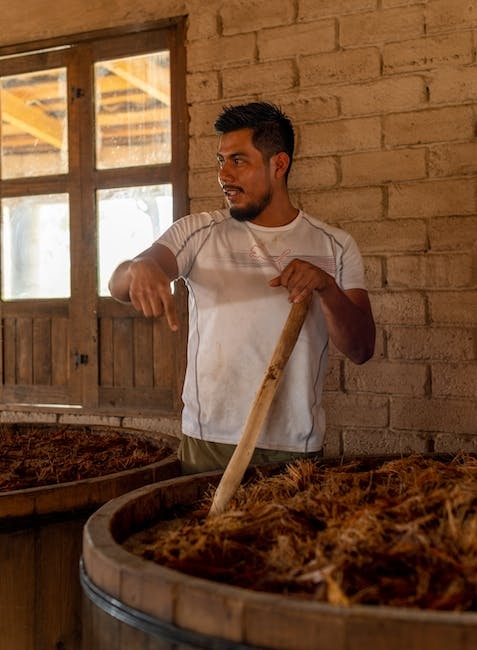The Fascinating History and Versatility of Tapioca Pearls
Have you ever tried bubble tea or a smoothie with chewy tapioca pearls? These small, sweet balls have become a popular addition to drinks and desserts around the world. But where do tapioca pearls come from, and how did they become such a beloved ingredient?
Origin and Production of Tapioca Pearls
Tapioca pearls, also known as boba, are made from tapioca starch. This starch is extracted from the roots of the cassava plant, which is native to South America. Tapioca has been a staple food in many South American and Asian countries for centuries, used in a variety of dishes including soups, stews, and porridges.
To make tapioca pearls, the cassava starch is mixed with water and shaped into small balls. These balls are then boiled until they become translucent and chewy. The pearls are often soaked in a sweet syrup before being added to drinks or desserts.
The Rise of Bubble Tea
In the 1980s, a Taiwanese tea shop owner named Liu Han-Chieh decided to add some fun and unique ingredients to his teas. He added tapioca pearls to his tea, creating a drink that became known as bubble tea. The bubbles referred to the foam that formed on top of the tea when it was shaken with ice.
Bubble tea quickly became popular in Taiwan and other parts of Asia, and eventually made its way to the United States in the 1990s. Today, bubble tea shops can be found all over the world, and tapioca pearls have become a staple ingredient in many other drinks and desserts.
Versatility of Tapioca Pearls
While bubble tea is still the most well-known use of tapioca pearls, these little balls have found their way into a variety of other dishes. They can be added to smoothies, milkshakes, and even ice cream. Tapioca pearls are also used in many traditional Asian desserts, such as mango sticky rice and coconut pudding.
One unique way to use tapioca pearls is in a Brazilian dish called “sagu.” This dessert is made by boiling tapioca pearls with spices and fruit juice until they become translucent and plump. The resulting pudding-like dish is sweet and refreshing, and often served with cream or condensed milk.
In Conclusion
Tapioca pearls have a fascinating history and a versatility that makes them a beloved ingredient in many cultures. Whether you’re sipping on bubble tea or enjoying a bowl of mango sticky rice, these little balls add a fun and satisfying texture to any dish. So the next time you come across tapioca pearls, give them a try in a new and exciting way!
Everything You Need to Know About Tapioca Pearls
Have you ever tried bubble tea or boba? If so, you’ve probably tasted tapioca pearls – those chewy little balls that sink to the bottom of the drink. Tapioca pearls come in different sizes and colors, and they’re made from tapioca starch. Here’s everything you need to know about cooking and using tapioca pearls:
Cooking Tapioca Pearls
To cook tapioca pearls, start by boiling water in a pot. Once the water is boiling, add the pearls and cook them until they become soft and chewy, but not mushy or hard. The cooking time varies depending on the size of the pearls and can range from 5 to 15 minutes. To enhance the flavor and texture of the pearls, you can add sugar or honey to the boiling water.
After cooking, rinse the pearls with cold water to stop the cooking process and prevent them from sticking together.
Storing Tapioca Pearls
To store tapioca pearls, keep them in a container with a lid and cover them with a sugar syrup or honey mixture to prevent them from drying out and becoming hard.
Using Tapioca Pearls in Drinks
When using tapioca pearls in a drink, it’s important to add them last and not to overcook them, as this can affect their texture and taste.
Safety Precautions
It’s important to note that tapioca pearls can be a choking hazard, especially for children, so they should always be consumed with caution and under adult supervision.
Conclusion
Tapioca pearls are a fun addition to drinks and desserts, but they require some care and attention when cooking and using. By following these tips, you can make sure your tapioca pearls turn out perfectly every time.
| Pros | Cons |
|---|---|
| Fun addition to drinks and desserts | Choking hazard, especially for children |
| Comes in different sizes and colors | Requires careful cooking and storing |
| Easy to make with water, sugar or honey | Overcooking can affect texture and taste |
As with any food, tapioca pearls have their pros and cons. While they’re a fun addition to drinks and desserts, it’s important to consume them with caution and under adult supervision. If you follow these tips for cooking and using tapioca pearls, you’ll be able to enjoy them safely and deliciously!
Exploring the World of Tapioca Pearls: From Bubble Tea to Thai Iced Coffee
If you’re a fan of bubble tea, you’re likely familiar with tapioca pearls. These small, chewy balls are a staple in this Taiwanese tea-based drink, which has become incredibly popular all over the world. But did you know that tapioca pearls can be used in a variety of other beverages as well? In this blog post, we’ll explore the world of tapioca pearls and the drinks they can be found in.

Bubble Tea
Let’s start with the most well-known use of tapioca pearls: bubble tea. This drink can be made with a variety of teas, including black, green, oolong, or fruit tea. Some popular flavors include milk tea, taro, matcha, and fruit flavors like mango or strawberry. The tapioca pearls, which are often referred to as “boba,” are added to the drink and create a unique texture and flavor combination.
Thai Iced Tea
Another tea-based drink that can use tapioca pearls is Thai iced tea. This sweet and creamy tea is often served with condensed milk and ice, and the addition of tapioca pearls creates a delightful chewy texture.
Hong Kong-Style Milk Tea
If you’re a fan of strong black tea, you might enjoy Hong Kong-style milk tea. This drink is made by straining black tea through a cloth and mixing it with evaporated or condensed milk. Adding tapioca pearls to this drink can create a fun twist on a classic beverage.
Coffee-Based Drinks
Tapioca pearls aren’t just for tea-based drinks – they can also be added to coffee-based drinks for a unique flavor and texture combination. Vietnamese iced coffee and Thai coffee are two examples of coffee-based drinks that can be served with tapioca pearls.
Conclusion
Tapioca pearls are a versatile ingredient that can be used in a variety of beverages. Whether it’s bubble tea, Thai iced tea, Hong Kong-style milk tea, or coffee-based drinks, adding tapioca pearls can create a fun and unique experience. So the next time you’re looking to switch up your drink order, consider trying something with tapioca pearls – you might just discover a new favorite!
Exploring the Delicious World of Flavored Tapioca Pearls
Have you ever tried tapioca pearls? These small, chewy balls are a staple in many Asian desserts and drinks, and are becoming increasingly popular in the western world as well. But did you know that tapioca pearls can be flavored in a variety of delicious ways? Let’s take a closer look at the wonderful world of flavored tapioca pearls.
Flavor Options
The beauty of tapioca pearls is that they can be infused with a wide range of flavors, depending on your taste preferences. Some popular flavor options include:
- Strawberry
- Mango
- Taro
- Lavender
- Rose
These flavors are typically added during the soaking or boiling stage of the preparation process, giving the pearls a burst of delicious taste.
Texture Variations
Tapioca pearls can also be made with different textures, depending on how long they are cooked and how much water is used. For those who prefer chewier pearls, shorter cooking times and less water will do the trick. On the other hand, those who prefer a softer texture can opt for longer cooking times and more water. It’s all about personal preference!
Enhancing the Flavor
If you want to take the flavor of your tapioca pearls to the next level, try adding ingredients like coconut milk, condensed milk, or honey. These ingredients can enhance the sweetness and creaminess of the pearls, making them even more delicious.
Fun Shapes and Colors
In addition to traditional round pearls, tapioca pearls can also come in fun shapes like cubes or stars. And for those who love vibrant colors, natural food dyes like beet juice or turmeric can be used to create colorful pearls that are as pleasing to the eye as they are to the palate.
Final Thoughts
Whether you’re a fan of traditional tapioca pearls or want to experiment with different flavors, textures, and shapes, there’s no denying that this versatile ingredient has a lot to offer. So why not give it a try and see where your taste buds take you?


Leave a Reply